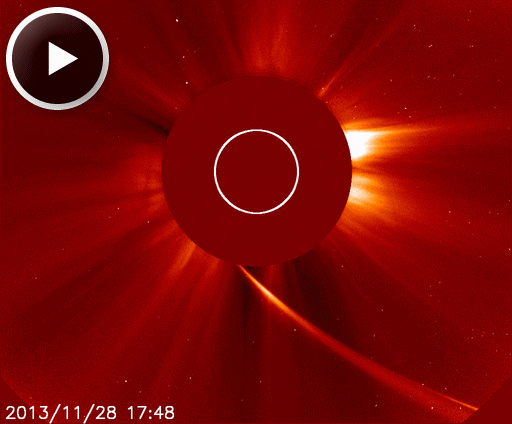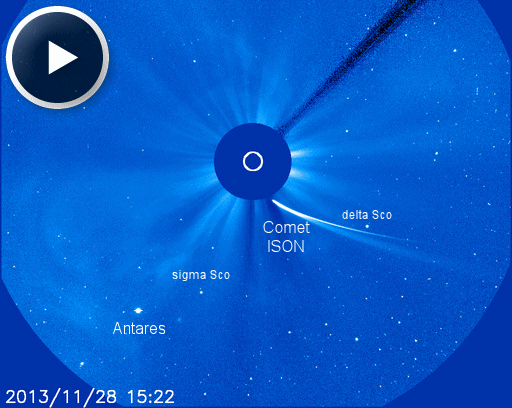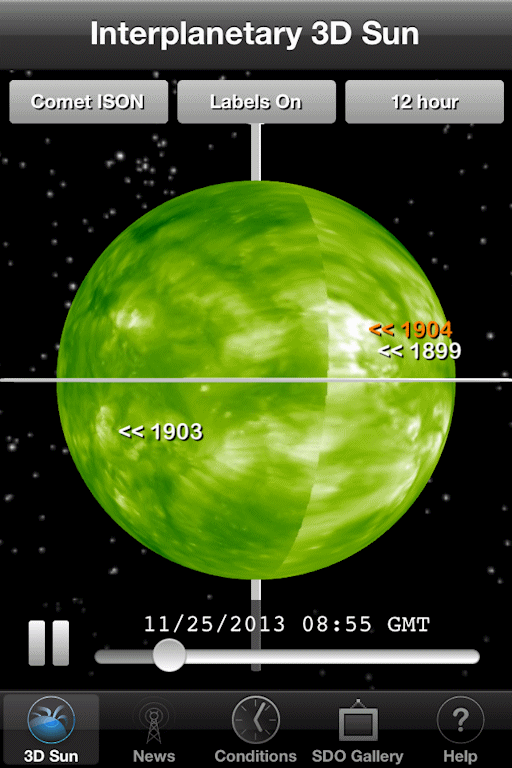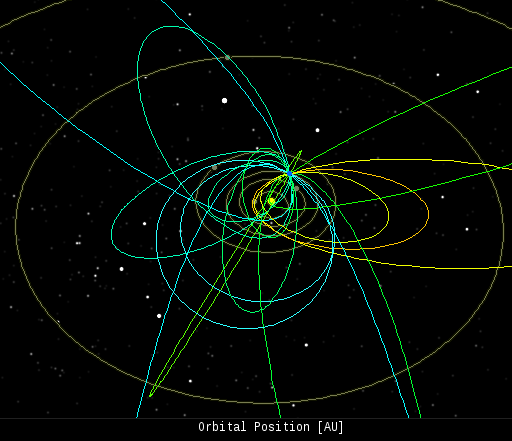When is the best time to see auroras? Where is the best place to go? And how do you photograph them? These questions and more are answered in a new book, Northern Lights - a Guide, by Pal Brekke & Fredrik Broms. | | | COMET ISON--UPDATE: New images from SOHO show something emerging from behind the sun. It could be a small fragment of Comet ISON's nucleus or perhaps a "headless comet"--a stream of debris marking the remains of the comet's disintegrated core. Watch the movie and stay tuned for updates. COMET ISON, R.I.P? Evidence is mounting that comet ISON did not survive its brush with the sun earlier today. At 01:45 EST on Nov. 28th, Thanksgiving Day in the USA, the comet was supposed to pass a little more than a million miles above the surface of the sun. As a new movie from SOHO shows, the comet had already disintegrated. Click to set the scene in motion, and pay careful attention to the head of the comet: 
In the movie, Comet ISON is clearly falling apart as it approaches the sun. Researchers working with the Solar Dynamics Observatory report that they are saw nothing along the track that ISON was expected to follow through the sun's atmosphere. Update: Nevertheless, something has emerged from the sun's atmosphere. Watch this movie all the way to the end. Whether this is a small fragment of Comet ISON's nucleus or perhaps a "headless comet"--a stream of debris marking the remains of the comet's disintegrated core--remains to be seen. An earlier movie from SOHO shows more of the comet's approach: 
The movie spans a day and a half period from Nov. 27th (01:41 UT) to 28th (15:22 UT). We see that Comet ISON brightened dramatically on Nov. 27th before fading on Nov. 28th. That brightening might have been the disintegration event, in which the comet cracked open and spilled its vaporizing contents into space. There is still a chance that some fraction of Comet ISON has survived. (That would make ISON a headless comet--more appropriate for Halloween than Thanksgiving.) Stay tuned for more movies as we watch for debris emerging behind the occulting disk of SOHO coronagraphs. Solar flare alerts: text, voice Realtime Comet ISON Photo Gallery WHICH SIDE OF THE SUN IS FACING COMET ISON? When Comet ISON sweeps through the sun's atmosphere on Nov. 28th, it will be in the 'hot zone' for CMEs. A strike by one of the massive storm clouds probably wouldn't destroy the comet, but it could have a dramatic effect on the comet's fragile tail. The odds of a strike depend on which side of the sun is facing the comet at the time of the flyby. This is something you can monitor using a NASA iPhone app called the Interplanetary 3D Sun: 
The app displays an interactive 3D model of the entire sun photographed by extreme UV cameras onboard NASA's twin STEREO probes. The data are realtime and fully interactive (pinch, spin and zoom). As shown in this target list, you can view the sun from many locations around the solar system--including Comet ISON. Active regions are color-coded by their potential for flares: Orange means "expect M-class solar flares," while red denotes sunspots capable of X-flares. In the screen shot above we see that, on Nov. 25th, Comet ISON was bearing down on an active region, AR1904, that posed a threat for M-class eruptions. What is targeting the comet today? Download the app and find out. Solar flare alerts: text, voice Realtime Space Weather Photo Gallery
Realtime Aurora Photo Gallery
Every night, a network of NASA all-sky cameras scans the skies above the United States for meteoritic fireballs. Automated software maintained by NASA's Meteoroid Environment Office calculates their orbits, velocity, penetration depth in Earth's atmosphere and many other characteristics. Daily results are presented here on Spaceweather.com. On Nov. 28, 2013, the network reported 20 fireballs.
(18 sporadics, 1 Quadrantid, 1 November omega Oriond) 
In this diagram of the inner solar system, all of the fireball orbits intersect at a single point--Earth. The orbits are color-coded by velocity, from slow (red) to fast (blue). [Larger image] [movies] Potentially Hazardous Asteroids ( PHAs) are space rocks larger than approximately 100m that can come closer to Earth than 0.05 AU. None of the known PHAs is on a collision course with our planet, although astronomers are finding new ones all the time. On November 28, 2013 there were potentially hazardous asteroids. Notes: LD means "Lunar Distance." 1 LD = 384,401 km, the distance between Earth and the Moon. 1 LD also equals 0.00256 AU. MAG is the visual magnitude of the asteroid on the date of closest approach. | | The official U.S. government space weather bureau | | | The first place to look for information about sundogs, pillars, rainbows and related phenomena. | | | Researchers call it a "Hubble for the sun." SDO is the most advanced solar observatory ever. | | | 3D views of the sun from NASA's Solar and Terrestrial Relations Observatory | | | Realtime and archival images of the Sun from SOHO. | | | from the NOAA Space Environment Center | | | the underlying science of space weather | | 
